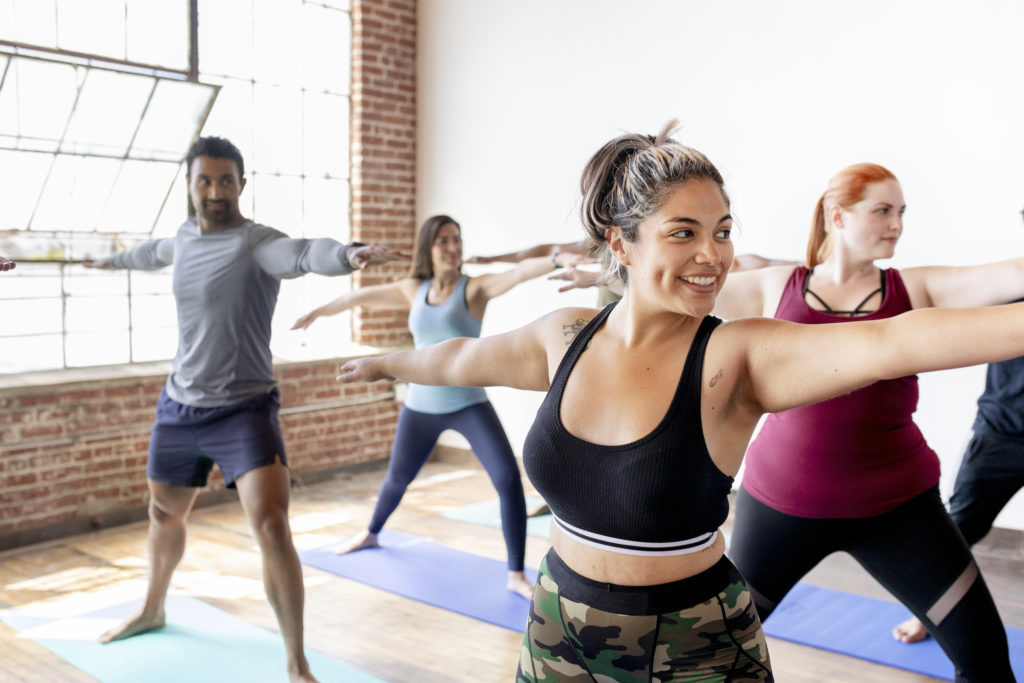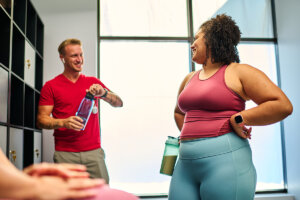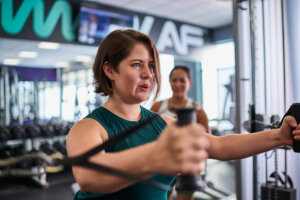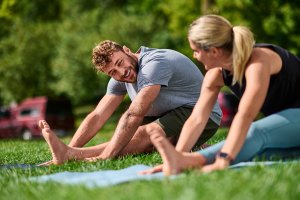According to the Yoga Alliance, 28% of Americans (in 2016) have practiced yoga at some point in their lives. That means many more are at least familiar with this form of exercise, because they know someone who practices. So why wait? It’s time to take away any mystique from those who have yet to try it!
Yoga is a brilliant cross-training, triple-threat that builds muscle strength, flexibility, and core in a low-impact, variable intensity workout—which means anyone can do it. Of course, to really understand the effectiveness of yoga, you must also take into account the mental aspect of the practice.
Benefits of Yoga
There are lots of impressive health benefits of yoga, particularly for those who engage in a regular yoga practice. Yoga can increase your flexibility within just a few weeks of your first class. It can also improve your muscle tone, strength, body awareness and posture – many fundamental yoga postures require you to keep your shoulders and spine straight. And yoga isn’t just great for your body – there are benefits for your emotional health and nervous system, too!
In addition to yoga’s general health benefits, it’s also helpful for specific conditions. Researchers have done systematic reviews to find that yoga is effective for reducing high blood pressure. In addition to high blood pressure, studies have also shown yoga to be beneficial for battling heart disease.
Yoga isn’t only good for your heart – Researchers who systematically reviewed literature around arthritis found evidence that yoga was effective in reducing arthritis symptoms, particularly joint pain. In another small study, researchers found that yoga can improve carpal tunnel syndrome: subjects who practiced yoga twice a week for eight weeks improved their grip strength and reduced their pain symptoms from carpal tunnel syndrome. And if you suffer from chronic lower back pain, recent studies have shown that a few weeks of downward dog can reduce pain. Whether you’re dealing with a condition as specific as chronic lower back pain or arthritis, or if you’d just like to improve your mobility, yoga can help. Of course, check in with your doctor first to see if it’s a good idea for you.
The effectiveness of yoga goes far beyond physical activity – evidence shows that it’s also great for your brain and nervous system! A systematically reviewed study found that yoga can be effective for anxiety and depression. Other systematic reviews have found evidence that the practice of yoga can lower cortisol levels and reduce the impact of stress responses, such as depression and anxiety. And even if you aren’t prone to depression or anxiety, yoga has great benefits for your energy and mood. Certain yoga poses are particularly effective for an energy boost or a mood boost!
Even if you’re not looking for a pick-me-up, yoga is still great for your mental and emotional health. Whether you’re engaging in a more meditative practice or something fast-paced, yoga requires concentration, mindfulness and the ability to stay in the present moment. Studies have shown that yoga can actually have the same effects as meditation. And the more you practice, the more easily that concentration will come.
Now, how should you begin? Here are the basics, from what to wear and bring, to how to choose the right experience and instructor.
Yoga Clothes: What To Wear
Don’t let anyone on Instagram tell you that you need to spend a ton of money on perfectly-coordinated yoga outfits and accessories. Most of the time, your regular workout clothes are fine for most yoga styles. You’ll want clothing that’s comfortable, made from breathable material (like cotton) and moves well with you.
Shoes: Most yoga is performed barefoot on your own mat, so feel free to leave your shoes at home (or outside the studio door). However, if you have a foot injury that prevents you from being barefoot or if you’re borrowing instead of using your own yoga mat, there are options. Check out Nike’s yoga shoe collection. Or, you can invest in a pair of Yoga Socks that help you grip, balance, and train your feet. ToeSox and Gaim’s Yoga Socks are both great options.
Pants/Shorts: There’s no need to run out and spend $100 on a pair of special yoga pants, especially not for new students. Simply choose comfortable pants or shorts that stretch – you probably already have something that will work in your regular workout clothes. Many yogis prefer tighter bottoms, like leggings or short shorts, to help check alignment and to keep everything covered when legs are in the air, but you can choose looser-fitting pants or tights (long or short) as well. Men will often pair looser bottoms with a compression garment underneath. But you’ll want to avoid pants with a belt, as you want clothing that moves with you, and a belt can get in the way.
Yoga Tops: A fitted T-shirt, tank or crop top is best to ensure the top stays in place while in a variety of poses. You will want to choose a moisture-wicking fabric for your yoga top, especially if you’ll be participating in a heated yoga room. Crop tops, if they’re not against your gym’s policy, can help keep your arms and stomach cool. Some people prefer tank tops so that their shoulders aren’t restricted, but then again, tank tops can also be colder if you aren’t practicing in a heated room. Whether or not your arms are exposed is entirely your preference. A wrap or long-sleeve shirt might be helpful to throw on during Savasana (final resting pose), as some participants tend to get chilled during this portion of class.
Women yogis will also want to take sports bras into consideration. When performing any form of exercise, a sports bra is a good choice over a regular bra, because it provides more comfort and support. Yoga is more low-impact than other exercises, so you might not need to wear your most padded and supportive sports bra. However, we’d definitely suggest a sports bra that suits your comfort over a traditional bra for women, since you’ll be moving a lot. Regular bra straps might dig into your shoulders and even your spine when you’re in Savasana.
Other Workout Clothes: If you have longer hair, you will most likely want to keep it off your face and neck for comfort. You’ll be moving a lot, and you’ll want to avoid getting hair in your face, particularly if you’re doing a class with inversions. Whatever hairstyle you choose, be sure it will be comfortable when you are lying down so that you can avoid head and neck pain during Savasana. If you’re taking a hot yoga class like Bikram yoga, you might want to bring a headband and a yoga towel. And you probably won’t want much jewelry on your skin, as it can be distracting if it jangles around on your arms.
Yoga Essentials: What To Bring
There are a few key items you’ll want to make sure you bring to your first class.
Mat: A yoga mat is essential. Most studios will have mats available if you don’t have your own (be prepared to rent the mat at private studios for $1-$2). But, if you’re going to be going to yoga regularly, investing in a quality yoga mat is a smart move. The two most important things about choosing a mat are that the mat should be non-slip and provide a bit of cushion. Use this Yoga Mat Comparison Chart to help you make your choice. If you plan to incorporate meditation into your practice, make sure you get a mat you can comfortably sit on for longer periods of time. If you have knee issues or hardwood floors (and plan to practice on your own floor at home), you’ll want a mat with extra cushion, since you’ll be on the mat for up to an hour.
Towel: You’ll need a towel to wipe away sweat throughout your practice. There are many microfiber towels available to fit the size of your mat (which is helpful in hot yoga classes). You can choose a towel to cover your mat and get the sweat off your skin, or just bring a hand towel to wipe occasional sweat.
Water Bottle: An hour-long practice, particularly if it’s hot yoga, is a long time to go without water. Be sure to stay hydrated during your yoga practice by keeping a water bottle handy. Choose a spill-proof bottle (in case you knock it over at some point) and keep it near the front of your yoga mat.
Yoga Studios & Instructors: Where To Go
With so many options available, it may seem overwhelming to even get started. Here are two easy steps.
Step 1: Choose the Best TYPE of Yoga for You
Fun fact: The original language of yoga is Sanskrit, which is why some words may sound unfamiliar. Each yoga pose has its own Sanskrit name, as well as an English name. For example, tree pose is also known as Vrikshasana. While you don’t need to know the differences between the English and Sanskrit poses, here’s some helpful information on two key words in yoga: pranayama, which refers to the practice of breathing and controlling the breath, and asana, which is the physical practice of yoga poses. Most people think of asanas when they think of yoga, but movement isn’t everything. Both pranayama and asana are incorporated to varying degrees in all types of yoga. Here’s a quick primer on the most common types of classes you’ll find. For your first time, you’ll probably want to try Hatha or Restorative yoga, which are a great way to get an introduction to the yoga world! Once you’ve begun a more regular yoga practice, you can expand into other types.
- Hatha: Technically, all yoga classes are hatha yoga. But this term is used most often today to describe a “basic” yoga class that is usually slower-paced, as Hatha yoga focuses on the fundamentals. Hatha classes are a great place to learn to pay attention to poses and breathing.
- Vinyasa: Vinyasa style classes flow from one pose to the next, are a bit faster-paced, and synchronize breath to movement. You’ll be doing a lot of upward and downward dogs!
- Ashtanga/Power Yoga: Ashtanga is considered a fast-paced, intense style of yoga as it is, typically, a set series of poses that are performed one after the other in the same order. Ashtanga focuses on daily practice and is the inspiration for a popular form of yoga called Power Yoga. Some consider Ashtanga/Power Yoga to be the most physically demanding and many yoga lovers favor this as an alternative for full body strengthening without weights.
- Iyengar: Alignment is the focus of an Iyengar class. Poses are held for a longer period of time and props (blankets, blocks, straps) are used to help with alignment.
- Bikram/Hot Yoga: This type of yoga is performed in a heated room (usually 95-105 degrees) to help loosen the muscles for enhanced flexibility. Bikram has a set series of 26 poses, but hot yoga does not. Be prepared to sweat, and check with a doctor about any health conditions you have before taking a hot yoga class.
- Restorative: Restorative is a gentle, peaceful yoga class that uses props to support passive stretching. This is a great class on a recovery day or if you are most interested in the relaxation side of a yoga practice. It’s adaptable for all fitness levels.
Of course, there are many more types, hybrids, and specialty yoga classes available. You’ll want to start out with a beginner class (even if you are active already) to learn poses, language, and the ins and outs of practicing yoga. Use this fun Yoga Personality Quiz to find the best style of yoga for you.
Step 2: Choose the best teacher
You’ll want to find a qualified yoga teacher to help guide you. Most yoga teachers train for 200 hours before receiving their certification, but teacher programs vary, and not all yoga teachers are created equal. One helpful suggestion is to use the Yoga Alliance Registry to search for the most qualified instructors in your area. Beyond their qualifications, you’ll need to find a style or personality that you like. Ask friends and family for suggestions and try a few teachers before finding the one that is perfect for you!
Yoga Etiquette: What To Do
Yoga has its own etiquette that is different from work out etiquette. To ensure a pleasant yoga experience, remember…
- Get to class early: It’s a good idea to give yourself 5-10 minutes to use the restroom, get your mat set up, and just sit for a few minutes. You might want to think of a word or an intention to focus on during your class. Having time to settle in, breathe, and focus on the class you’re about to take will help you get the most from your yoga experience. You definitely don’t want to rush in right when class starts!
- Communicate with your instructor: If you have injuries, special considerations, questions, or even if you’re just a bit nervous about the class, chat with the instructor prior to getting started. A good yoga instructor will be able to personalize the class and help you feel comfortable with modifications, adjustments or extra help.
- Quietness: Yoga is a relaxing workout and most people come to de-stress and block out the outside world. Keep your conversations outside the studio door and/or whisper if you need to talk to someone beside you. And if you must bring your cell phone into the classroom, be sure it’s silenced with no possibility of going off during your practice. Think about creating the same physical space that you would for meditation.
- Respect others: Beyond being quiet, respecting others encompasses appropriate mat spacing, being mindful of where you place your “extras” (props, water bottle, towel), and your odor. Of course, odor can refer to body odor (be sure to wear deodorant), but you should also be aware of the lotions or perfumes that you wear to yoga class.
- Stay for Savasana: The final few minutes at the end of class are probably the most crucial; if you can, please stay for this important final resting pose. If you must leave class early, make sure to do so prior to the rest of the class settling in for Savasana (also known as corpse pose), and let the instructor know prior to class that you will be doing so. You should make every attempt to stay for this last thing and take a moment to close your eyes, keep your attention focused on your body, and let things settle. Plus, your fellow students will be grateful you aren’t disturbing their practice with a lot of noise!
Yoga is a wonderful addition to any workout regime. If you find the right class, a good instructor, and invest some time into learning the basics, you’ll quickly experience the physical and mental benefits of yoga.
Namaste.



